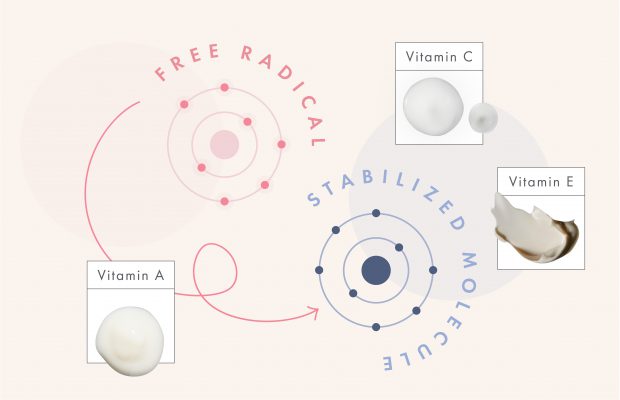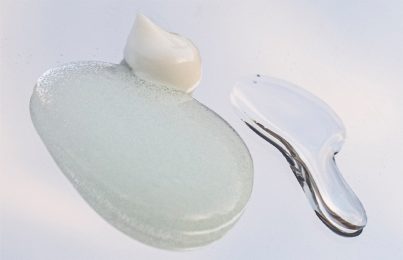Updated 03/10/22. Sharing skincare knowledge is important to me, which is why I constantly stay up to date on trends and innovations in the skincare industry. I attend tradeshows, work closely with chemists, and read scientific journals. I’ve also completed several courses in advanced cosmetic chemistry at UCLA. During these courses, I learn about new skincare ingredients, product formulations, and more.
The latest skincare lesson I want to share is all about the free radical theory of aging. It was first proposed in the 1950s and thousands of papers have been published on it since. This theory states that the main reason we age is unstable electrons in molecules known as free radicals attack healthy cells and change their composition. This makes them unable to function the way normal cells do. Over time, this causes signs of aging, like lines and wrinkles, to appear.
In this post, I’ll discuss this theory in-depth and explain why I’m a believer in it. I’ll also discuss how you can mitigate the effect of free radicals with skincare!
What Are Free Radicals?
To understand free radicals, we have to go back to chemistry class (just for a second!). To put it simply, free radicals are unstable molecules. Instead of a pair of electrons spinning around a nucleus, there is only one. This causes the molecule to become unstable. The single electron wants to be paired, so it attaches itself to other molecules in the cell, causing cellular damage.
These free radicals are very potent toxins that damage our skin because they attach to the proteins, DNA, and other essential molecules, making them unstable to function normally and causing premature cell death. (I know, it sounds tragic!)
What Causes Free Radicals?
While our bodies naturally produce and quench free radicals through regular metabolic processes in cells, the skin is also exposed to free radicals from UVA and UVB rays, pollution, stress, smoking, alcohol, fatty foods, and even repetitive aerobic exercise.
The parts of the cells that are damaged are DNA, lipids, and proteins. This slows down the production of collagen and elastin which are both essential in keeping the skin firm. This happens very gradually, causing signs of aging like wrinkles, brown spots, and sagging to become apparent over time.
What Are The Types of Free Radicals?
Molecular biologists have identified three families of free radicals.
1. Reactive Oxygen Species (ROS)
This is the most damaging type of free radical. We are exposed to ROS from the air we breathe (oxygen), cigarette smoke, sunlight, stress, and smog. This type of free radical causes oxidative stress by attacking all areas of the cell, mutating DNA, and destroying the skin’s moisture barrier. It can also damage the dermis layer of the skin, cause inflammation, and give the skin wrinkles, brown spots, and a rough texture.
2. Reactive Carbonyl Species (RCS)
This is a carbon-based radical resulting from alcohol consumption and eating simple carbohydrates such as sugar, white flour, white rice, and pasta. RCS causes glycation, which is when a sugar-like coating forms over the skin’s proteins. This makes them hard and inflexible, resulting in loss of tone (sagging) as well as deep wrinkles and fine lines.
3. Reactive Nitrogen Species (RNS)
This type of free radical is nitrogen-based and is found mainly in the environment. Common sources are parks, woods, farmlands, and gardens. Nitrogen-rich soil, like fertilizers, car exhaust, and the “exhalations” made by trees all emit RNS. These change proteins in the skin, thereby increasing inflammation and triggering cell death.
While this all might sound dramatic and scary, I have some good news, too, so keep reading!
Can I Prevent Free Radical Damage?
Yes—antioxidants to the rescue! Applied topically and taken internally, antioxidants (like stabilized Vitamins A, C, and E) are great at slowing the process of aging. Here’s how they work. Remember that lonely electron that wanted to be paired so badly? Antioxidants can give free radicals one of their electrons without becoming unstable themselves. This prevents free radicals from attaching to the molecules in healthy cells and causing damage.
When it comes to internal antioxidants, look for darkly pigmented fruits and vegetables. They’re extremely important to consume daily. Topical antioxidants, on the other hand, are one of the very best ways to prevent oxidative stress and mitigate free radical activity. Make sure to apply skincare products that contain stable antioxidants to the face every day.
What Are The Best Free Radical-Fighting Skincare Ingredients?
Antioxidants are essential to a well-rounded skincare routine since they can slow the effects of free radicals. Here are five of my favorite antioxidant ingredients to use.
1. Retinol (Vitamin A)
A lot of people don’t know this, but retinol (also known as vitamin A) is actually an antioxidant. Aside from offering antioxidant benefits, it also increases the rate of cell turnover to reveal younger-looking skin. This helps build collagen, which retinol also protects by decreasing the activity of enzymes that break collagen down.
2. Vitamin C
Vitamin C is a powerful antioxidant, but not all forms of vitamin C are the same. Some of them are notoriously unstable. That’s why I suggest looking for vitamin C serums that contain tetrahexyldecyl ascorbate, magnesium ascorbyl phosphate, ascorbyl palmitate, and/or ascorbyl methylsilanol pectinate. These are stable and less likely to irritate the skin compared to other, traditional forms of vitamin C.
3. Astaxanthin
Astaxanthin is a reddish pigment found in certain algae (like red marine algae). As an antioxidant, this ingredient works by sitting on the surface of the skin and scavenging free radicals to stop them from inflicting damage. It’s also a soothing ingredient that can help calm inflammation and combat redness.
You can find this ingredient in the Firm + Repair Overnight Serum. I formulated it with a mix of powerful antioxidants and peptides to help keep the skin firm and healthy-looking.
4. Niacinamide
Niacinamide is one of skincare’s most versatile ingredients and boasts antioxidant properties among its many talents. It’s unique because, in addition to acting as an antioxidant itself, it also increases the antioxidant potential of the skin. In other words, it supports your skin in a way that allows it to produce more of its own antioxidants.
5. Green Tea Extract
Most people are already aware of the health benefits of drinking green tea, but did you know it’s a great skincare ingredient as well? Green tea extract is chock-full of polyphenols, a powerful class of antioxidants. One type of green tea extract emerging in skincare is ECGC (which stands for Epigallocatechin Gallate). It’s been shown to eliminate reactive oxygen species in the skin.
The Bottom Line
The free radical theory of aging accounts for one important aspect of aging. However, aging is a cumulative effect of all mechanisms in the body. So, in order to encourage healthy aging, it’s important to lead an active lifestyle and care for your skin, as well as your body and mind!
Next, learn how peptides can help build and protect collagen for more youthful-looking skin!
Celebrity Esthetician & Skincare Expert
As an esthetician trained in cosmetic chemistry, Renée Rouleau has spent 35 years researching skin, educating her audience, and building an award-winning line of products. Her hands-on experience as an esthetician and trusted skin care expert has created a real-world solution — products that are formulated for nine different types of skin so your face will get exactly what it needs to look and feel its best. Trusted by celebrities, editors, bloggers, and skincare obsessives around the globe, her vast real-world knowledge and constant research are why Marie Claire calls her “the most passionate skin practitioner we know.”




Comments:
The Vitamin C&E Complex is to be used daily under SPF so start with that one! You’ll love it!
Posted By: Renée Rouleau |
Great Article!!! Which product should we use if we can only get one….vit c or the white tea?? They all sound great!!!!
Posted By: Amy |